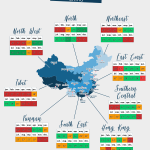The Huangyaguan Great Wall (Yellow Cliff Pass) is situated in the mountainous area of Ji County in Tianjin City, which is 130 km east of Beijing. Originally constructed in the Northen Qi Dynasty (550-557) and it was repaired by General Qi Jiguang in the Ming Dynasty (1368-1644). The Huangyaguan Great Wall connects the Malanguan Pass in the east in Hebei Province and the General Pass in the east in Beijing City with a total length of 42 kilometers, and 52 watch towers and 14 beacon towers were built along this section. The rock and cliff to the east of the pass are always yellowish at the dusk, hence its name. This section of the wall was restored again between 1984-1986, and opened to the public in 1987. There are 20 watch towers being restored with total length of 3 kilometer.
The Huangyaguan Great Wall was built on an abrupt mountain ridge. Being endowed with both natural beauty and cultural interest, it’s divided into two areas: Huangyaguan Pass and Taipingzhai Mountain Stronghhold.
Huangyaguan Pass This section is 2152 meters long and combined with the Huangya Fortress, the water pass, watch towers, the frontier cities, the Bagua Castle, as well as military facilities. The defense system of the wall is still intact. The Phoenix Fortress, located in the north of the pass, was one of the beacon towers left from ancient times to deliver message in case of emergency. The Bagua Castle was built on the idea of Eight Diagrams, which come from the ancient philosopy, the Book of Changes. Even the enemy could break into the pass, they would easily got lost and attacked by the soldiers. A Great Wall Museum and Forest of Steles were established when the restoration was going in 1980s.
Taiping Mountain Stronghold
Six miles northwest of Huangyaguan Pass and built 400-500 meters above sea level, the stronghold is located in Xiaopingan Village. There are 6 watch towers along the 873-meter-long mountain ridge. It controls the Chongshan Valley east of Huangyaguan Pass. The Widow Tower was built in the western end of this section. It is said that 12 wives contributed their smart money to build a watch tower when they came here to find their husbands were dead. A rock statue of Qi Jiguang was erected here in memory of his great work to defend the captial.
The Huangyaguan Great Wall retains several features:
Strong: With its walls and towers built on mountain ridge with an average altitude of 738 meters, the Huangyaguan is really overwhelming. To the east there is the cliff, and the west, crags. It winds its way across mountains like a dragon. Guarding a stronghold, it has been the north entrance of Ji County.
Steep: On the mountains with peaks rising one higher than another, the wall jumps its way up and down as a linkage between the cliff and crags. Since the mountain is sloppy, the steps are very high. In some sections, it looks like that the wall is running straight up or down. When you look down, you will feel dizzy at the sight.
Ancient: With a history of over 1400 years, the ancient wall was reserved well until today. In Ming Dynasty, it was added with walls made of bricks. The International Great Wall Marathon was held here every May from 1999, and a part of the race is on the wall. More than 1500 runners attended the event in 2009.




















